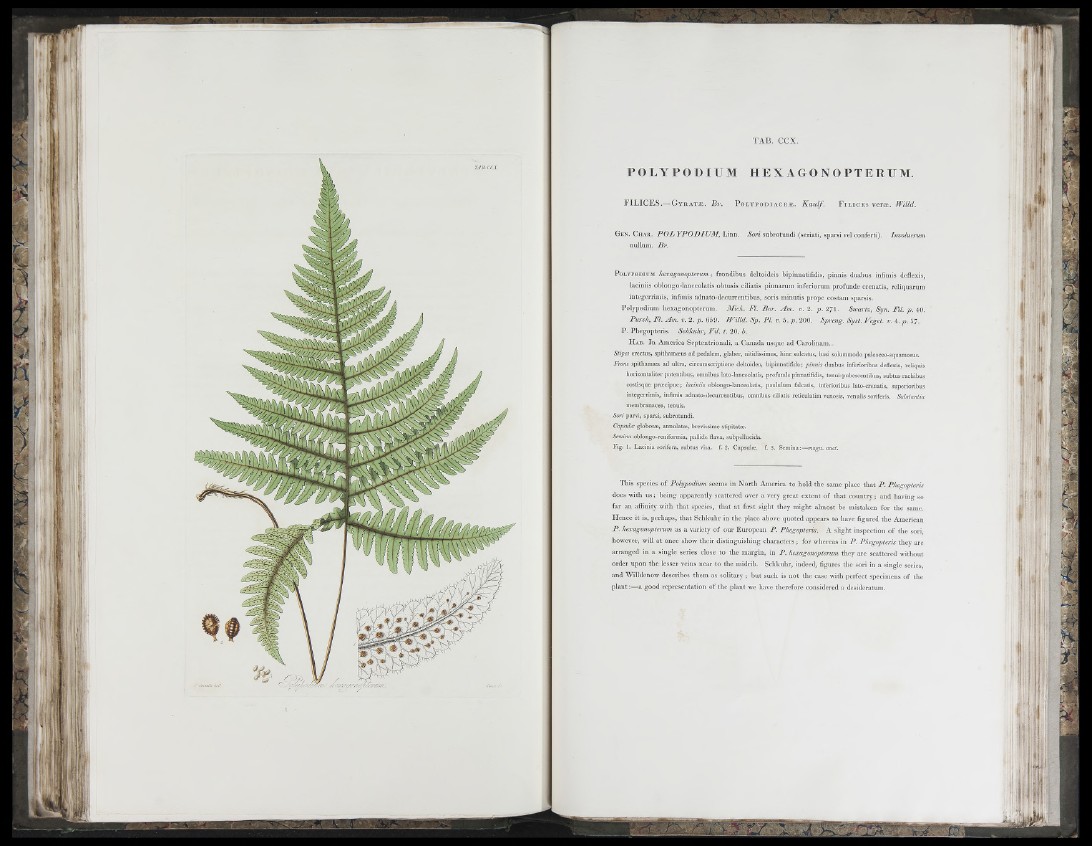
A i
■ ì Û ' 1;
I L t ,
P O L Y P O D I U M I I L X A G O N O P T L R UM.
F IL ICE S .—G y r a t æ . B r . P o l y p o d i a c e æ . K a u lf . F i l i c e s veræ. Willd.
G e n . C h a r . P O L Y P O D I U M , «yo?-/s u b r o t u n d i ( s e r i a t i , s p a r s i v e l c o n f e r t i ) . Involucrum
n u l lu m . Br.
P o l y p o d iu m h e x a g o n o p t e m m ; frondibus deltoidcis bipinnatifidis, pinnis duabus infimis deflexis,
laciniis ob longo-lanceolatis obtusis ciliatis pinnarum inferiorum profunde crenatis, rcliquarurn
integerrimis, infimis adnato-decurrentibus, soris minutis propc costam sparsis.
Polypodium hexagonopterum. M i c h . F l . B o r . A m . v . 2. p . 2 7 1 . S w a r t z , S y n . F i l . p . 4 0.
P u r s h , F l . A m . v . 2 . p . 6 5 9 . I F i l l d . S p . P l . v . 5. p . 2 0 0 . S p r e n g . S y s t . F e g e t , v . A. p . 5 7 .
P. P h egop te r is. S c h k u h r , F i l . t . 2 0 . b.
H au. In America Septentrionali, a Canada usque ad Carolinam.
S tip e s erectus, spithamæus ad pedalem, glaber, nitidissimus, hinc sulcatus, basi solummodo paleaceo-squamosus.
F ro n s spiüiamoea ad ultra, circumscriptione deltoidea, bipinnatifida; p in n is duabus inferioribus deflexis, reliquis
horizontabter patentibus, omnibus lato-lanceolatis, profunde pinnatifidis, teiiui-pubescentibus, subtus rachibus
costisque præcipue; la c in iis oblongo-lanceolatis, paululum falcatis, inferioribus lato-crenatis, superioribus
integerrimis, infimis adnato-decurrentibus, omnibus ciliatis reticulatim venosis, venulis soriferis. S u b stantia
membranacea, tenuis.
Sen i parvi, sparsi, subrotundi.
Capsulæ globosæ, annulatæ, brevissime stipitatoe.
S emin a oblongo-reniformia, pallide flava, subpellucida.
Fig . 1. Lacinia sorifera, subtus visa. f . 2 . Capsuloe. f. 3. Sem ina :—magn. auct.
This species of Polypodium seems in North America to hold the same place that P. Phegopteris
docs with ns ; being apparently scattered over a very great extent of that country; and having so
far an affinity with that species, that at first sight they might almost be mistaken for the same.
Hence it is, perhaps, that Schkulir in the place above quoted appears to have figured the American
P . hexagonopterum as a variety of our European P . Phegopteris. A slight inspection of the sori,
however, will at once show their distinguishing characters ; for whereas in P . Phegopteris they arc
arranged in a single series close to the margin, in P . hexagonoptei-um they are scattered without
order upon the lesser veins near to the midrib. Schkuhr, indeed, figures the sori in a single series,
and Willdenow describes them as solitary ; but such is not the case with perfect specimens of the
plant a good representation of the plant we have therefore considered a desideratum.